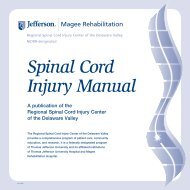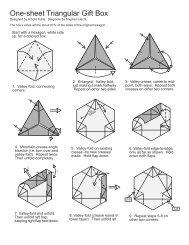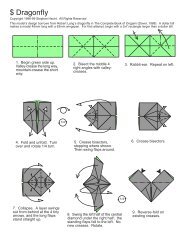Spasticity and Spinal Cord Injury - Datarealm
Spasticity and Spinal Cord Injury - Datarealm
Spasticity and Spinal Cord Injury - Datarealm
- No tags were found...
Create successful ePaper yourself
Turn your PDF publications into a flip-book with our unique Google optimized e-Paper software.
<strong>Spasticity</strong> <strong>and</strong> <strong>Spinal</strong> <strong>Cord</strong> <strong>Injury</strong><strong>Spinal</strong> <strong>Cord</strong> <strong>Injury</strong> Model Systems Consumer InformationThis publication wasproduced by the SCI ModelSystems in collaborationwith the Model SystemsKnowledge TranslationCenter (http://msktc.washington.edu) withfunding from the NationalInstitute on Disability <strong>and</strong>Rehabilitation Researchin the U.S. Departmentof Education, grant no.H133A060070.What is spasticity?<strong>Spasticity</strong> is the uncontrolled tightening or contracting of the muscles that iscommon in individuals with spinal cord injuries. About 65%–78% of the SCIpopulation have some amount of spasticity, <strong>and</strong> it is more common in cervical(neck) than thoracic (chest) <strong>and</strong> lumbar (lower back) injuries .Symptoms <strong>and</strong> severity of spasticity vary from person to person <strong>and</strong> can include:• Sudden, involuntary fl exing (bending) or extending (straightening) of a limb,or jerking of muscle groups such as in the trunk (chest, back, <strong>and</strong> abdomen),bladder, or rectum.• Hyperactive (overactive) refl exes, such as a muscle spasm when you arelightly touched.• Stiff or tight muscles at rest, so that it is diffi cult to relax or stretch yourmuscles.• Muscle tightness during activity, making it diffi cult for you to control yourmovement.What causes spasticity?The nerves of the spinal cord <strong>and</strong> brain form a complex communication circuitthat controls our body movements. Information on sensations or processessuch as touch, movement or muscle stretch is sent up the spinal cord to thebrain. In response, the brain interprets the signal <strong>and</strong> sends the necessarycomm<strong>and</strong>s back down the spinal cord to tell your body how to react. Thereaction of the body, such as jerking away from a hot object, is a refl ex <strong>and</strong>happens quickly <strong>and</strong> automatically.After a spinal cord injury, the normal fl ow of signals is disrupted, <strong>and</strong> the messagedoes not reach the brain. Instead, the signals are sent back to the motorcells in the spinal cord <strong>and</strong> cause a refl ex muscle spasm. This can result in atwitch, jerk or stiffening of the muscle.Just about any touch, movement or irritation can trigger <strong>and</strong> sustain spasms.Common triggers are:• Stretching your muscles.• Moving your arm or leg.• Any irritation to the skin, such as rubbing, chafi ng, a rash, in-grown toenails,or anything that would normally be very hot or cold or cause pain.• Pressure sores.• A urinary tract infection or full bladder.Copyright © 2011 Model Systems Knowledge Translation Center (MSKTC).
<strong>Spinal</strong> <strong>Cord</strong> <strong>Injury</strong> Model Systems Consumer Information• Constipation or large hemorrhoids.• Fracture or other injury to the muscles, tendonsor bone below the level of spinal cord injury.• Tight clothing, wraps or binders.<strong>Spasticity</strong> can be irritating, inconvenient or evenlimit your ability to go through your day.What are the benefits of spasticityin SCI?<strong>Spasticity</strong> is not always harmful or bothersome <strong>and</strong>does not always need to be treated. Sometimesspasticity can help with functional activities such asst<strong>and</strong>ing or transferring. <strong>Spasticity</strong> that causes yourfi ngers to bend can help you grip objects. <strong>Spasticity</strong>can also be a signal that you have a medicalproblem that you might not know about otherwise,such as a urinary tract infection, fracture, orpressure sore.What problems are caused byspasticity?• <strong>Spasticity</strong> can be painful.• <strong>Spasticity</strong> can result in loss of range of motion inyour joints (contractures).• Severe spasms can make it diffi cult for youto drive or transfer safely, or to stay properlyseated in your wheelchair.• <strong>Spasticity</strong> in your chest muscles may make it difficult to take a deep breath.• Strong spasms in the trunk or legs can cause youto fall out of your wheelchair when you changeposition, transfer, or ride over uneven surfaces.• Repeated muscle spasms at night can cause youto sleep poorly <strong>and</strong> be tired during the day.• Spasms can cause rubbing that leads to skinbreakdown.• <strong>Spasticity</strong> can make movement harder to control,so that activities such as feeding yourselfmay be more diffi cult.Managing spasticity after SCIFirst, practice healthy behaviors <strong>and</strong> good self-carethat will help you avoid problems that can increasespasticity, such as urinary tract infections <strong>and</strong> skinbreakdown. Check to see if any of the commontriggers listed above may be causing the problem.Physical treatmentsThe following treatments will help to maintain fl exibility<strong>and</strong> therefore reduce spasticity <strong>and</strong> the riskfor permanent joint contracture:• Regular stretching (range-of-motion) exercisestwice daily will help maintain fl exibility <strong>and</strong> temporarilyreduce muscle tightness.• Weight-bearing or st<strong>and</strong>ing with support, suchas using a st<strong>and</strong>ing frame or other supportivedevices, will help stretch muscles.• Splints, braces, or progressive casting into thedesired position provides continuous musclestretching that helps to maintain fl exibility <strong>and</strong> aposition that does not trigger a spasm.• Careful use of hot or cold packs. When used inbody areas that have partial sensation, check skintolerance frequently as it may result in a burn if toohot <strong>and</strong> frostbite if too cold. Avoid the use of hotpacks over areas without sensation.MedicationsWhen physical measures are not enough to controlspasticity, medications may be needed.• Oral medicationsIf spasticity involves large areas of your body, yourdoctor may prescribe one or more of the followingmedications:• Baclofen• Benzodiazepines (muscle relaxants) such asdiazepam, clonazepam• Dantrolene• TizanidineThe effectiveness of these medications varies witheach person. Because these medications can haveside effects such as fatigue or drowsiness, weakness,nausea, or sometimes low blood pressure, yourprovider needs to monitor you closely.• Nerve or motor point blocksIf only part of your body has spasticity, anestheticmedications, alcohol, phenol or neurotoxins (suchas strains of botulinum toxin) can be injected intothe muscles that have spasticity. The medicationsrarely cause widespread side-effects. The benefi ts ofthe injections are only temporary, however, so injectionsmust be repeated a few times a year. Theseinjections can be used alone or in combination withoral spasticity medications.<strong>Spasticity</strong> <strong>and</strong> <strong>Spinal</strong> <strong>Cord</strong> <strong>Injury</strong>Page 2 of 3
<strong>Spinal</strong> <strong>Cord</strong> <strong>Injury</strong> Model Systems Consumer InformationSurgery• Intrathecal medication therapy (alsocalled a “pump” or “baclofen pump”)Intrathecal drug therapy uses a surgically placed,battery-powered pump <strong>and</strong> an attached catheterto deliver medication directly into the spinal canal,around the spinal cord (called the “intrathecal”space). The most commonly used intrathecal drugfor spasticity is baclofen. Intrathecal baclofen canbe used in conjunction with the other treatmentslisted above. This treatment is generally not recommendeduntil other treatments have been tried<strong>and</strong> failed to provide relief or if oral medicationscause unacceptable side effects.Advantages of intrathecal baclofen:• The drug is delivered directly around the spinalcord, so lower doses of medication are needed.• Fewer negative side effects because the drugdoes not enter the bloodstream.• The amount <strong>and</strong> dosing schedule of drugthroughout the day can be precisely set <strong>and</strong>adjusted by the health care provider to meeteach individual patient’s needs.• The pump can be stopped or removed, if necessary.Disadvantages of intrathecal baclofen:• You will need surgery to implant the pump <strong>and</strong>catheter system. Any surgery has risks, such asinfection.• The pump has a limited battery life <strong>and</strong> willneed to be replaced about every 5-7 years.• You will need to go to your provider periodicallyfor pump refi lls (done by injecting baclofenthrough the skin into the pump reservoir).Mechanical problems with the device may occur<strong>and</strong> could result in a baclofen overdose or underdose.For this reason, it is important for you tounderst<strong>and</strong> the risks, monitor yourself carefully,<strong>and</strong> get regular follow-up from your provider.• Other SurgeryOther surgical treatments for spasticity are farless commonly performed because they are notreversible. These include cutting a section of thespinal cord (myelotomy) or nerve roots (rhizotomy),or lengthening <strong>and</strong> transposing a tendon. Yourdoctor will discuss these surgical options with youif necessary.Which treatment is best for me?Discuss your specifi c needs <strong>and</strong> treatment optionswith your health care provider or team. You mayneed to try different methods, medications, orcombinations of treatments before you feel yourspasticity is under control. Consider the followingquestions <strong>and</strong> discuss them with your provider:• What are your goals for treatment of yourspasticity?• How important is it that the treatment can bereversed or stopped?• What are the possible short-term <strong>and</strong> long-termside-effects of each treatment?• Are there other health conditions that wouldinfl uence the treatment choice?• If you are considering intrathecal baclofen: Willyou be able to follow the maintenance requirements?Do you have a good underst<strong>and</strong>ing ofthe possible risks <strong>and</strong> benefi ts?Whatever treatment you choose, you will needto work closely with your treatment provider orteam to get the best possible outcome.What happens to spasticity over time?In general, spasticity appears to become less bothersomeover time. Possibly this happens becausepeople learn to avoid things that trigger spasticity.Changes that naturally go on in the body as youage, such as a slowing down of nerve conduction,may also decrease spasticity. However, an unexplained,sudden or dramatic change in your spasticitylevel may sometimes signal a problem, so letyour health care provider know immediately.SourceOur health information content is based on research evidencewhenever available <strong>and</strong> represents the consensus ofexpert opinion of the SCI Model System directors.Authorship<strong>Spasticity</strong> <strong>and</strong> <strong>Spinal</strong> <strong>Cord</strong> <strong>Injury</strong> was developed by Maria R.Reyes, MD <strong>and</strong> Anthony Chiodo, MD, in collaboration withthe Model Systems Knowledge Translation Center.Portions of this document were adapted from materials developedby the University of Michigan <strong>and</strong> UAB Model Systems.DisclaimerThis information is not meant to replace the advice froma medical professional. You should consult your health careprovider regarding specifi c medical concerns or treatment.<strong>Spasticity</strong> <strong>and</strong> <strong>Spinal</strong> <strong>Cord</strong> <strong>Injury</strong>Page 3 of 3











